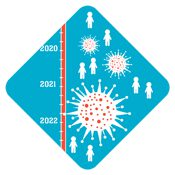The virus celebrated the New Year with the highest local death toll of the pandemic: twenty-two county residents died in the week ending January 2.
As Omicron took hold, new infections set their own record the next week, with 1,229 in a single day. No one was surprised when hospitalizations set their own record the week after that. Even Mott Children’s Hospital ran short of intensive-care beds.
 Public health workers were on overload, too. “The state health department formalized what has been happening in practice because of limited capacity and the need to focus on the most vulnerable individuals or situations,” emails WCHD’s Susan Ringler-Cerniglia. “With transmission so high, it’s not possible for most (any?) health department to effectively investigate or trace all cases and the information is less useful (i.e. exposures are everywhere).” They’re focusing tracking “on people and situations where severe illness is more likely and/or there is the potential for rapid spread/greater impact,” she writes, like “long term care facilities, group homes, jails/prisons, schools, shelters, and dormitories …
Public health workers were on overload, too. “The state health department formalized what has been happening in practice because of limited capacity and the need to focus on the most vulnerable individuals or situations,” emails WCHD’s Susan Ringler-Cerniglia. “With transmission so high, it’s not possible for most (any?) health department to effectively investigate or trace all cases and the information is less useful (i.e. exposures are everywhere).” They’re focusing tracking “on people and situations where severe illness is more likely and/or there is the potential for rapid spread/greater impact,” she writes, like “long term care facilities, group homes, jails/prisons, schools, shelters, and dormitories …
“With Omicron, we’re hearing more reports of sore throats initially as well as severe body aches and other common COVID symptoms,” she adds. “Isolate yourself if you have symptoms and get tested. Continue isolation while you wait for test results (and after, if positive).”
What’s ahead? “I wish I knew,” Ringler-Cerniglia writes. “If the current wave follows the pattern we saw with last fall/early winter, then we’d expect [to] see a decline in cases soon or as we move into February. Of course, if this pattern holds, it also means we can expect a spring surge.”